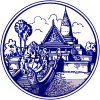Phnom Penh
ភ្នំពេញ | |
|---|---|
| |
Phnom Penh skyline View of Phnom Penh from the Mekong river | |
Nicknames:
| |
 | |
| Coordinates: 11°34′10″N 104°55′16″E / 11.56944°N 104.92111°E | |
| Country | Cambodia |
| Settled | 5th century[2] |
| Founded | 1372 |
| Capital status | 1434–1497 |
| Capital re-established | 1865 |
| Named for | Wat Phnom and Lady Penh |
| Subdivisions | 14 khans[3] |
| Government | |
| • Type | Municipal council |
| • Governor | Khuong Sreng (CPP) |
| • National Assembly | 12 / 125
|
| Area | |
| 679 km2 (262 sq mi) | |
| • Metro | 3,858 km2 (1,490 sq mi) |
| • Rank | 24th |
| Elevation | 11.89 m (39.01 ft) |
| Population (2023 census)[4] | |
| • Rank | 1st |
| • Density | 3,361/km2 (8,700/sq mi) |
| • Rank | 1st |
| • Metro | 3,483,532 |
| Demonyms |
|
| Time zone | UTC+07:00 (ICT) |
| Area code | +855 (023) |
| HDI (2021) | |
| Website | phnompenh |
| Phnom Penh | |
|---|---|
| Khmer name | |
| Khmer | ភ្នំពេញ UNGEGN: Phnum Pénh GD: Phnum Penh ALA-LC: Bhnaṃ Beñ IPA: [pʰnomˈpɨɲ] |
Phnom Penh[a] is the capital and most populous city of Cambodia. It has been the national capital since the French protectorate of Cambodia and has grown to become the nation's primate city and its economic, industrial, and cultural centre. Before Phnom Penh became capital city, Oudong was the capital of the country.
Phnom Penh succeeded Angkor Thom as the capital of the Khmer nation but was abandoned several times before being reestablished in 1865 by King Norodom. The city formerly functioned as a processing center, with textiles, pharmaceuticals, machine manufacturing, and rice milling. Its chief assets, however, were cultural. Institutions of higher learning included the Royal University of Phnom Penh (established in 1960 as Royal Khmer University), with schools of engineering, fine arts, technology, and agricultural sciences, the latter at Chamkar Daung, a suburb. Also located in Phnom Penh were the Royal University of Agronomic Sciences and the Agricultural School of Prek Leap.[9]
The city was nicknamed the "Pearl of Asia" for its early 20th century colonial French architecture, which included Art Deco works.[10] Phnom Penh, along with Siem Reap and Sihanoukville, are significant global and domestic tourist destinations for Cambodia. Founded in 1372, the city is noted for its historical architecture and attractions. It became the national capital in 1434 following the fall of Angkor, and remained so until 1497.[11] It regained its capital status during the French colonial era in 1865. There are a number of surviving colonial-era buildings scattered along the grand boulevards.
On the banks of the Tonlé Sap, Mekong, and Bassac Rivers, Phnom Penh is home to more than 2 million people, approximately 14% of the Cambodian population.[4] The Greater Phnom Penh area includes the nearby Ta Khmau city and some districts of Kandal province.[12]
The city has hosted numerous regional and international events, the most notable being the 2002, 2012, and 2022 ASEAN Summit, the 32nd Southeast Asian Games, and the 12th ASEAN Para Games. Phnom Penh will be the first Cambodian city and the second city in Southeast Asia to host the Asian Youth Games in 2029.[13]
- ^ "ISO 3166 — Codes for the representation of names of countries and their subdivisions: Cambodia KH". ISO. Retrieved October 28, 2018.
- ^ Bennett Murray (February 14, 2015). "Ancient kiln site poised to 'disappear forever'". Retrieved March 14, 2021.
- ^ Soth, Koemseoun (January 31, 2019). "Government establishes new districts, town for better management". The Phnom Penh Post. Retrieved July 9, 2019.
Two new districts, Boeung Keng Kang and Kamboul, have been added to Phnom Penh, the sub-decree states.
- ^ a b "General Population Census of the Kingdom of Cambodia 2019 – Final Results" (PDF). National Institute of Statistics. Ministry of Planning. January 26, 2021. Retrieved January 26, 2021.
- ^ "Sub-national HDI – Area Database – Global Data Lab". hdi.globaldatalab.org. Retrieved January 23, 2023.
- ^ Wells, John (April 3, 2008). Longman Pronunciation Dictionary (3rd ed.). Pearson Longman. ISBN 978-1-4058-8118-0.
- ^ "Phnom Penh". Phnom Penh | Definition of Phnom Penh in US English by Oxford Dictionaries. Oxford Dictionaries | English. Oxford University Press. Archived from the original on June 6, 2019. Retrieved June 6, 2019.
- ^ "Phnom Penh". Collins English Dictionary. HarperCollins Publishers. Retrieved June 6, 2019.
- ^ "Phnom Penh". Encyclopedia Britannica. Retrieved February 5, 2021.
- ^ De Launey, Guy (June 17, 2011). "Phnom Penh's fast-fading architectural treasures". BBC News. Retrieved November 12, 2022.
- ^ "History of Phnom Penh". phnompenh.gov.kh. Phnom Penh Capital Hall. Retrieved August 18, 2019.
- ^ "Facts: Phnom Penh". Phnom Penh Capital Hall. Retrieved July 21, 2020.
- ^ "OCA » Cambodia to host OCA's 5th Asian Youth Games in 2029". ocasia.org. Retrieved August 1, 2023.
Cite error: There are <ref group=lower-alpha> tags or {{efn}} templates on this page, but the references will not show without a {{reflist|group=lower-alpha}} template or {{notelist}} template (see the help page).









